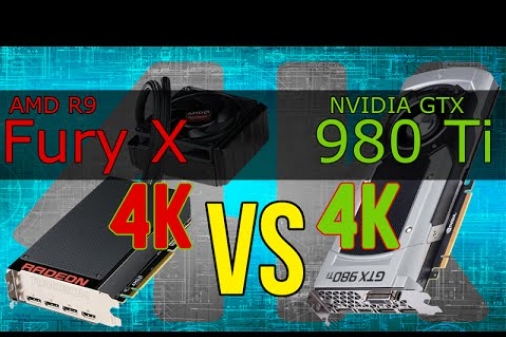
After its recent release, Nvidia Geforce GTX 980 Ti has made waves with a performance comparable with the Titan X while maintaining a $650 price tag, or $350 less than that of the latter.
Even after AMD's R9 Fury X release, the 980 Ti still stood its ground as the best bang-for-buck graphics card in the market. However, recent benchmarks of the two Fury X on Crossfire going head to head with twoTitan X and two 980 Ti on SLI may offer a different take on the real race leader for triple 4k displays.
Anthony Garreffa published the benchmarks through TweakTown last July 6. Gareffa had three Acer XB280HK monitors set up in a 4k Eyefinity display setup. Each of the monitors were on a 3840x2160 resolution (4k), which amounts to 6480x3840 in portrait mode.
However, the display was set up in landscape and hence, the resolution was 11,520x2160. Note that a full HD display sits at 1920x1080 (1080p) while the current gaming consoles are running games within the 720p to 900p range.
Having insanely high resolution translates to more insane pixels per second figures. A normal 1080p display renders 124 million pixels per second. The triple 4k display at 11,520x2160 and 6480x3840, however, renders 1.4 billion pixels in a second, more than ten-fold that of the 1080p.
All the cards were tested using the same system unit: an Intel Core i7 5820k processor, Gigabyte X99 Gaming G1 motherboard, 16 GB Corsair Vengeance DRR4 memory sticks clocked at 2666MHZ, 240GB SanDisk Extreme II and 480GB SanDisk Extreme II SSDs. The whole system unit set up was running on a 64-bit Windows 7 Ultimate.
Garreffa first tested the cards on Unigine Heaven, where the Titan X on SLI and the 980Ti on SLI came out on top of the Fury X. Both Nvidia cards averaged 15 frames per second compared with the Fury X's 13. They also won against the Fury X on Tomb Raider, where the 980 Ti unleashed its inner beast and averaged 77 fps compared with the 73 fps and 70 fps of the Titan X and the Fury X, respectively.
However, the Fury X made its mark on Battlefield 4, where it was averaged 70 fps while the 980 Ti was at 60fps and surprisingly, the Titan X was only at 47 fps. It also beat the Nvidia cards on Bioshock Infinite and Shadow of Mordor. And although the GTX 980 Ti was closely behind the Fury X on the mentioned games, the Titan X on SLI just can't seem to keep up.
There was little to no difference between the 980 Ti and the Fury X for Metro: Last Night and Thief. The Titan X fell a bit off on Metro but redeemed itself on Thief.
Based on the benchmarks, it becomes apparent that the choices, for at triple 4k at least, now falls between Fury X and 980 Ti. Both cards made the Titan X feel big and obsolete, almost a dinosaur.
However, it should be taken into account that Garreffa has yet to clarify if he was using a reference 980 Ti graphics card or one of the latest beefed up and modded ones from Asus, Zotac, Gigabyte and other Nvidia add-in-board partners.
The Nvidia reference card for the 980 Ti has a GPU that was clocked at 1000MHz. Zotac and Asus have recently released GTX 980 Ti variants that have base clock speeds of at least 1200 MHz and boost clock speeds of more than 1300 MHz. These figures can rise significantly when overclocked.













